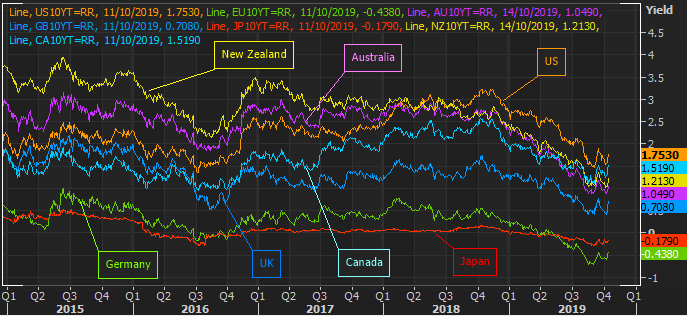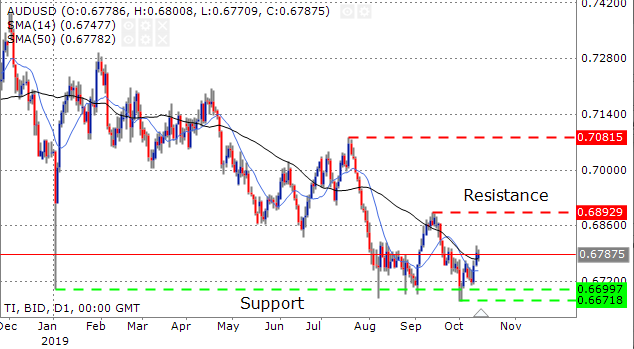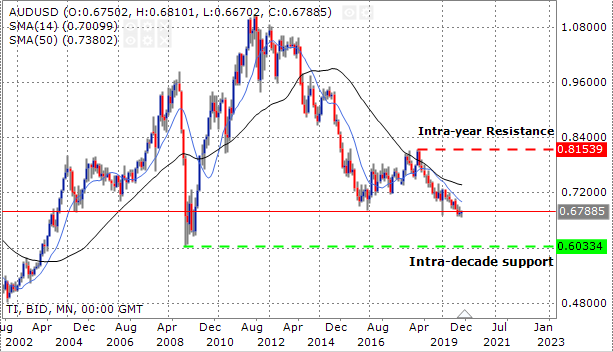*RBA could use UMPTs after one or two more rate cuts
*Open market operations, explicit guidance and QE not outrageous
*AUD at 0.60 - what needs to happen?
What is unconventional monetary policy?
The unity in major central bank monetary policy has seen a global downshift in interest rates as G10 economists look to prop up their economies in the face of slowing growth and lingering geopolitical risks. A problem however emerges when interest rates hit zero; what most people would regard as an effective lower bound. Of course, in the case of Europe and Japan, interest rates are currently below zero and have been for some time. Though, whether that's been effective or not in stimulating the economy is another question; it hasn't. Therefore, central banks have been looking to stimulate and guide the economy through other means: unconventional monetary policy tools (UMPT). UMPT simply means any type of central bank tool that avoids the traditional setting of interest rates in a central bank's time immemorial pursuit of price stability, full employment and economic growth.

10y bond yields have been falling since late 2018, %. Source: Eikon
The RBA hint at UMPTs. But when?
Recent BIS reports written by a committee chaired by RBA Gov Lowe concluded that unconventional monetary down the track could be used as an effective tool to address economic downturns. The RBA have in previous statements viewed UMPTs as unlikely but "would consider unconventional monetary policy...if the circumstances were to warrant it". Those circumstances could start to present themselves with 1-2 more rate cuts that put the RBA's cash target rate in the region of 0.25%-0.50%, down from the current 0.75%. With markets implying a 60% probability that the RBA undertake a 25bps cut at November's meeting - it could be sooner than we think.
And in what form?
There are numerous forms UMPTs could take in 1) negative rates (BoJ, ECB); 2) explicit forward rate guidance; 3) quantitative easing (buying government debt; ECB do this); 4) quantitative easing (buying equities, corporate bonds; BoJ do this); 5) funding credit lending (ECB's TLTRO); and 6) open market operations (OMOs - currently a hot topic for the Fed).
However, the RBA are likely to avoid some items more than others. Funding for Aussie banks seems unlikely given the effectiveness of macro-prudential regulation in levering credit supply. While buying equities and corporate debt in a Japan-like QE set-up isn't needed unless there's a severe and prolonged structural sell-off in Aussie risk assets.
Issues in passing through the October's 25bps rate cut to mortgage holders by the big 4 Aussie banks have been well documented. The issue stems from high funding costs among the banks. Therefore, the RBA are more inclined to use open market operations (similar to what the Fed do) to help reduce bank funding costs and increase pass-through. At the most recent meeting, the RBA said they were "prepared to ease monetary policy further" and that it was "reasonable to expect an extended period of low interest rates". The RBA could easily alter this language by providing explicit guidance around when interest rates could change based on reaching inflation targets.
AUDUSD impact
If the RBA do decide to unleash UMPTs, expect further declines in AUDUSD with a possible long-term target to the downside of 0.60, levels unseen since the GFC. Considering the multi-year downtrend in AUDUSD remains intact, the 200D-SMA points down and the Fed maintains a relative hawkish stance to the RBA in the medium-term; it's hard to see AUDUSD breaching the next major level of resistance at 0.6893 before it tests Oct. lows of 0.667.

AUDUSD daily chart. Source: ThinkMarkets

AUDUSD monthly chart. Source: ThinkMarkets
Back